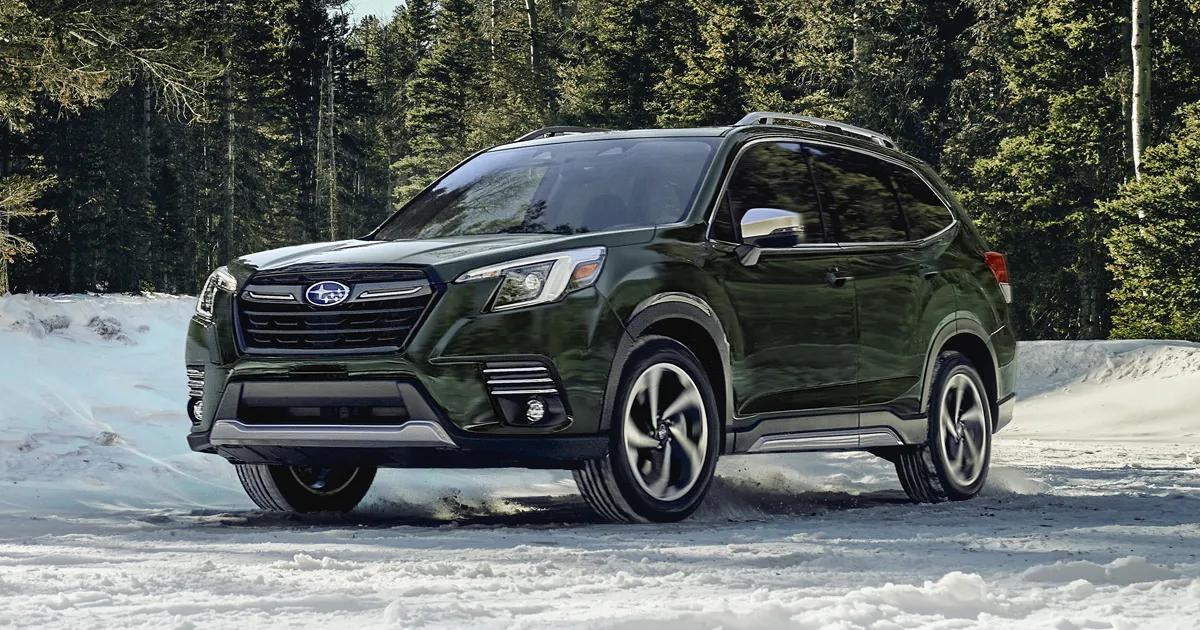 Subaru Forester 2023 Maintenance Schedule Base
Subaru Forester 2023 Maintenance Schedule Base
The 2023 Subaru Forester adheres to a thorough maintenance program that guarantees the car’s continuous dependability and performance. Although precise timings may differ based on variables including driving style and weather, Subaru normally advises important maintenance to be done on a regular basis. In addition to tire rotations every 6,000–8,000 miles, air filter replacements every 15,000–30,000 miles, and coolant changes every 30,000–50,000 miles, these also include oil changes every 6,000–7,500 miles. The owner’s manual’s maintenance schedule for the Forester offers a thorough breakdown of these chores, assisting owners in maintaining their cars and guaranteeing a safe and pleasurable drive.
2023 Subaru Forester Specs, Price, Features, Mileage (Brochure)
Maintenance schedule
U.S. models
The scheduled maintenance items required to be serviced at regular intervals are shown in the “Warranty and Maintenance Booklet”. For details, read the separate “Warranty and Maintenance Booklet”.
Canada models
The scheduled maintenance items required to be serviced at regular intervals are shown in the “Warranty and Service Booklet”. For details, read the separate “Warranty and Service Booklet”.
Except for U.S. and Canadian models
Some items of your vehicle are required to be serviced at scheduled intervals. For details about your maintenance schedule, read the separate “Warranty and Maintenance Booklet”.
NOTE
For models with a multi-function display (color LCD), you can set a reminder to be displayed when a scheduled maintenance item is almost due.
Maintenance precautions
When maintenance and service are required, it is recommended that all work be done by an authorized SUBARU dealer. If you perform maintenance and service by yourself, you should familiarize yourself with the information provided in this section on general maintenance and service for your SUBARU. Incorrect or incomplete service could cause improper or unsafe vehicle operation. Any problems caused by improper maintenance and service performed by you are not eligible for warranty coverage.
WARNING
- Always select a safe area when performing maintenance on your vehicle.
- Always be very careful to avoid injury when working on the vehicle. Remember that some of the materials in the vehicle may be hazardous if improperly used or handled, for example, battery acid.
- Your vehicle should only be serviced by persons fully competent to do so. Serious personal injury may result to persons not experienced in servicing vehicles.
- Always use the proper tools and make certain that they are well-maintained.
- Never get under the vehicle supported only by a jack. Always use safety stands to support the vehicle.
- Never keep the engine running in a poorly ventilated area, such as a garage or other closed areas.
- Do not smoke or allow open flames around the fuel or battery. This will cause a fire.
- Because the fuel system is under pressure, replacement of the fuel filter should be performed only by your SUBARU dealer.
- Wear adequate eye protection to guard against getting oil or fluids in your eyes. If something does get in your eyes, thoroughly
wash them out with clean water. - Do not tamper with the wiring of the SRS airbag system or seatbelt pre-tensioner system, or attempt to take its connectors apart, as this may activate the system or render it inoperative. NEVER use a circuit tester for this wiring. If your SRS airbag or seatbelt pre-tensioner needs service, consult your nearest SUBARU dealer.
- Check the inside of the engine compartment to see if there are any clothes and tools left. If they are left inside, they may be a cause of malfunction and fire.
NOTE
SUBARU does not endorse the use of non-SUBARU-approved flushing systems and strongly advises against performing these services on a SUBARU vehicle. Non-SUBARU-approved flushing systems use chemicals and/or solvents that have not been tested or approved by SUBARU. SUBARU warranties do not cover any part of the vehicle that is damaged by adding or applying chemicals and/or solvents other than those approved or recommended by SUBARU.
Before checking or servicing the engine compartment
- Always stop the engine and apply the parking brake firmly to prevent the vehicle from moving.
- Always let the engine cool down. Engine parts become very hot when the engine is running and remain hot for some time after the engine has stopped.
- Do not spill engine oil, engine coolant, brake fluid, or any other fluid on hot engine components. This may cause a fire.
- When the ignition switch is in the “ON” position, the cooling fan may operate suddenly even when the engine is stopped. If your body or clothes come into contact with a rotating fan, that could result in serious injury. To avoid the risk of injury, perform the following precautions.
- Models with push-button start system: Always turn the push-button ignition switch to the “OFF” position and confirm that the operation indicator on the switch is turned off. Then take the access key fob out from the vehicle.
- Models without push-button start system: Always remove the key from the ignition switch.
- Before performing any servicing on a vehicle equipped with a remote engine start system (a dealer option), temporarily place the remote engine start system in service mode to prevent it from unexpectedly starting the engine. 450 Maintenance precautions
When checking or servicing the engine compartment
 CAUTION
CAUTION
- Do not touch the engine cover while checking the components in the engine compartment. Doing so may cause your hand
to slip off the cover and result in an unexpected injury. - Do not touch the oil filter until the engine has cooled down completely. Doing so may result in a burn or other injury. Note that the oil filter becomes very hot when the engine is running and remains hot for some time after the engine has stopped.
When checking or servicing the engine compartment while the engine is running
A running engine can be dangerous. Keep your fingers, hands, clothing, hair, and tools away from the cooling fan, drive belt, and any other moving engine parts. Removing rings, watches, and ties is advisable.
FAQ
Subaru typically recommends changing the engine oil every 6,000 to 7,500 miles or as indicated in the owner’s manual.
Tire rotations are typically recommended every 6,000 to 8,000 miles to ensure even tire wear.
Subaru recommends replacing the engine air filter every 15,000 to 30,000 miles, but check the owner’s manual for specific intervals.
Coolant changes are typically recommended every 30,000 to 50,000 miles but refer to the owner’s manual for specific intervals.
Some Forester models may require transmission fluid changes; consult the owner’s manual for specific intervals.
At 30,000 miles, consider tasks such as coolant change, brake inspection, and checking the suspension components.
Regular maintenance includes checking the AWD system’s fluid levels and ensuring proper tire maintenance to maintain AWD performance.
Brake pad and rotor replacement intervals can vary depending on driving habits and conditions; inspect them regularly and replace when necessary.
When the “Check Engine” light comes on, it’s advisable to have the vehicle’s onboard diagnostic system scanned by a mechanic to identify and address any issues.
Depending on the engine, the Forester may have a timing belt or timing chain with varying replacement intervals. Refer to the owner’s manual for details.
Yes, many basic maintenance tasks can be performed by the owner. Consult the owner’s manual for guidance and follow safety precautions.
Routine maintenance includes checking and maintaining the battery, fuses, and electrical connections.
Unusual noises or vibrations can be signs of various issues, such as worn components or loose parts. Have the vehicle inspected by a mechanic to diagnose and address the problem.
Yes, regular maintenance helps keep the Forester in good condition, ensuring longevity and potentially increasing its resale value.
The Forester’s maintenance schedule and guidelines are provided in the owner’s manual, offering comprehensive information on routine servicing and maintenance tasks.
Useful Link
View Full User Guide: Subaru Forester 2023 Base User Guide
Download Manuals: https://www.subaru.com/owners/vehicle-resources/manuals.html
2023 Subaro Forester Specs, Price, Features, Mileage (Brochure)

